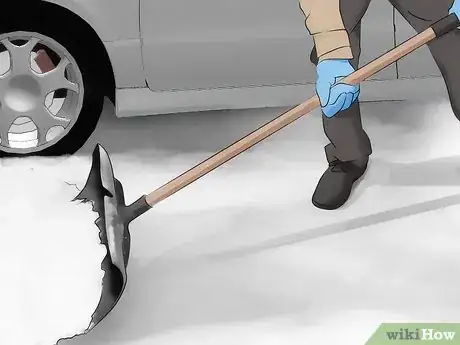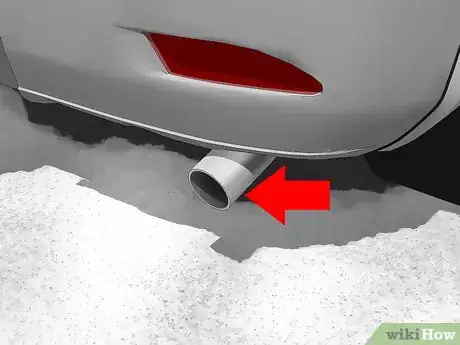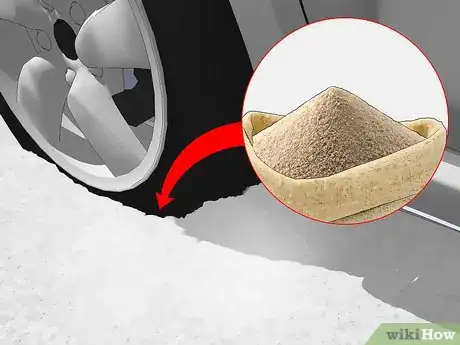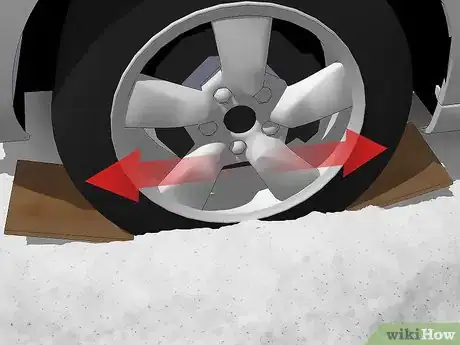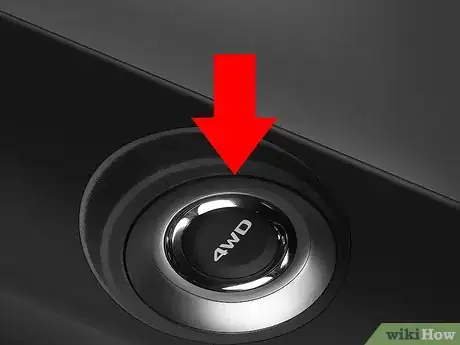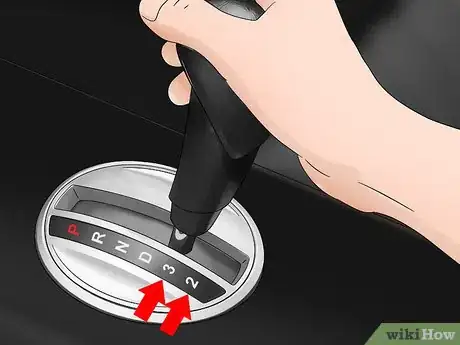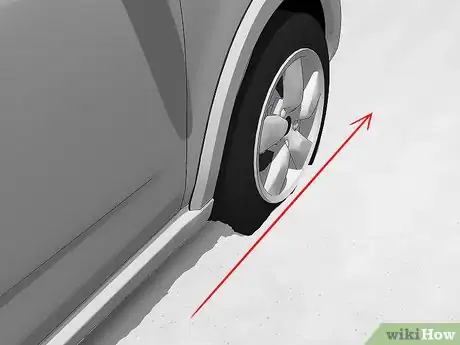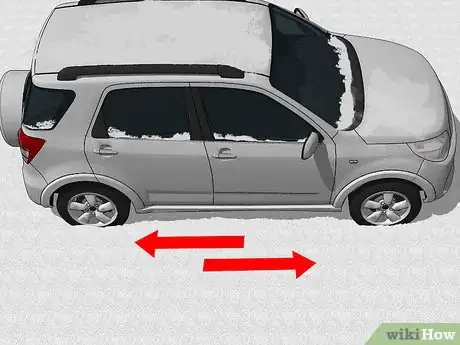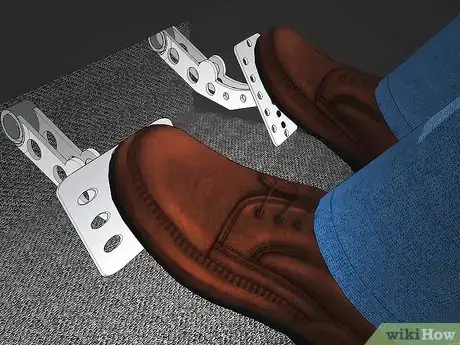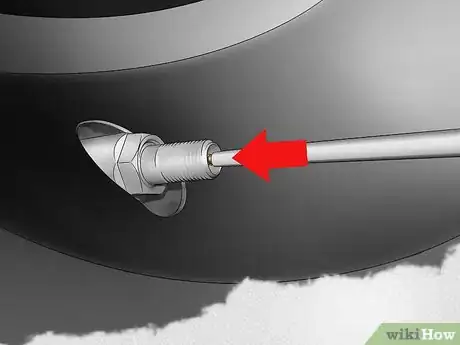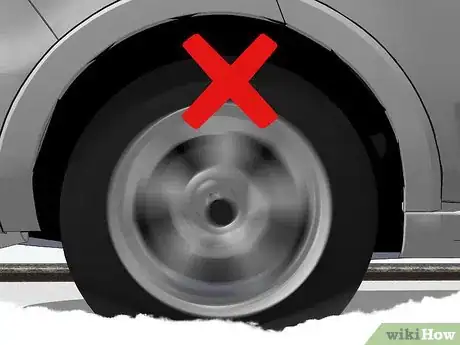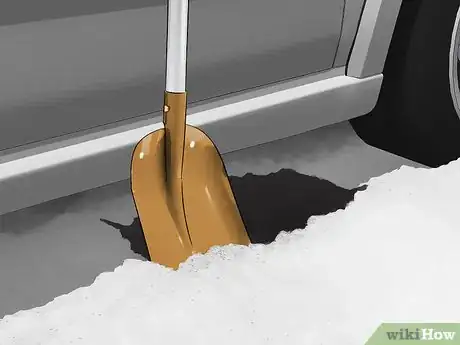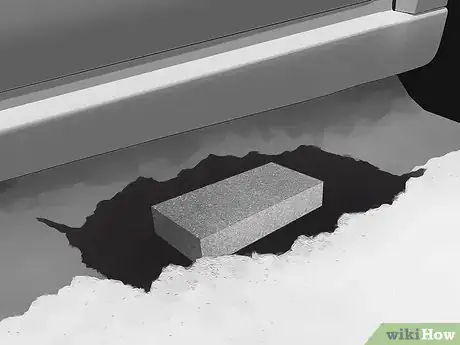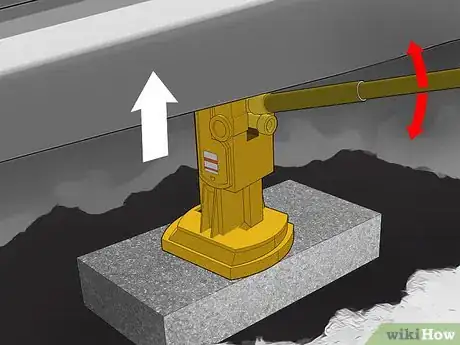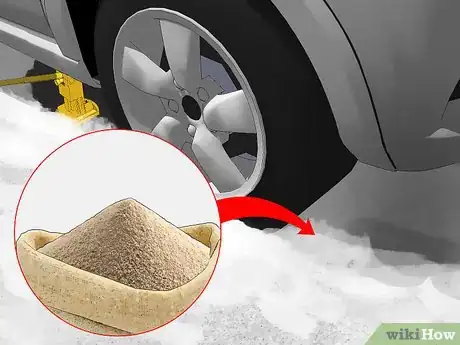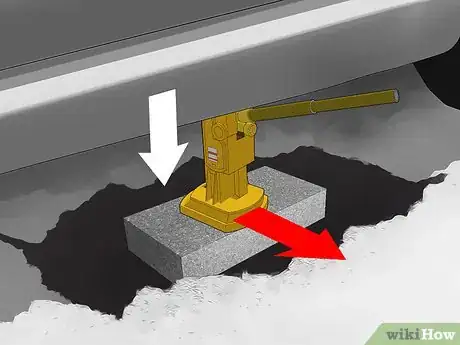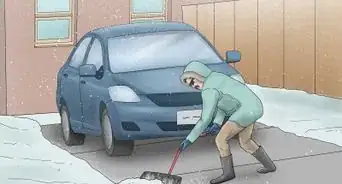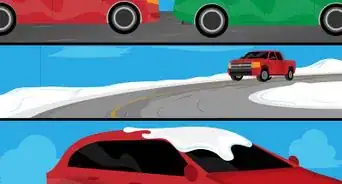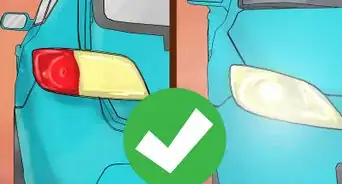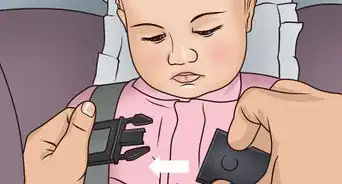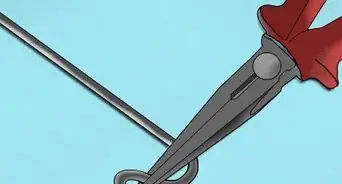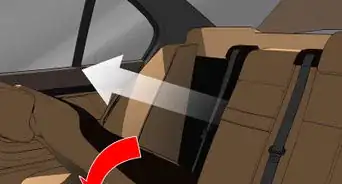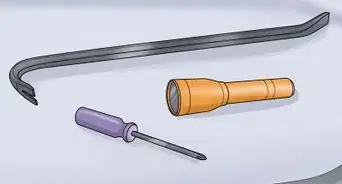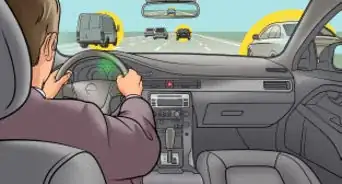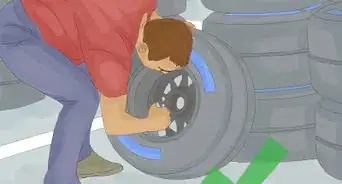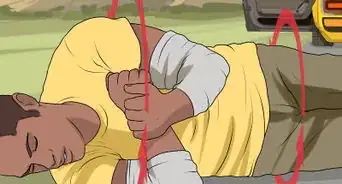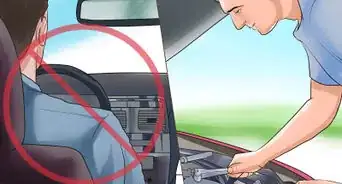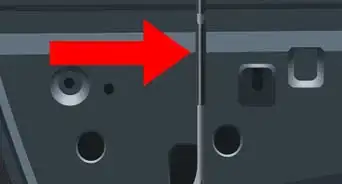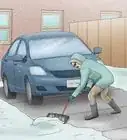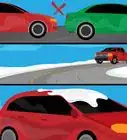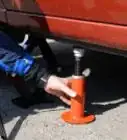This article was co-authored by wikiHow Staff. Our trained team of editors and researchers validate articles for accuracy and comprehensiveness. wikiHow's Content Management Team carefully monitors the work from our editorial staff to ensure that each article is backed by trusted research and meets our high quality standards.
There are 7 references cited in this article, which can be found at the bottom of the page.
This article has been viewed 864,938 times.
Learn more...
Getting stuck in the snow - whether your car veered off the road or it snowed while your car was parked - can be frustrating. However, while it may seem difficult to get your car out of the snow once it is stuck, there are a lot of things you can do to help free it. By removing snow from around your car, helping your car gain traction, and carefully driving your car out, you’ll have a better chance of getting your car out of the snow.
Steps
Removing Snow and Readying the Ground
-
1Dig out your car. Use a shovel or similar tool to clear away snow that surrounds the car. Try to make it so you can see all the tires. If there is ice be aware of it. [1]
- In very heavy and/or deep snow, you may have to prioritize your efforts. Be sure to dig out tires and enough so you can get in the car.
- You may not have to remove ice that is textured. Ice that is rough will add traction, so usually not worth removing.
-
2Check the tailpipe before you start the engine. After you’ve dug out your car, make sure that the tailpipe is free of snow. While you may have removed the snow from around it, make sure the tailpipe itself is clear and doesn’t get buried again. This is important, as the exhaust could build up in the car if the tailpipe isn’t clear.Advertisement
-
3Put down something gritty around the tires. Pour a gritty substance in front, behind, and on the sides of your tires. Gritty substances will help your tires gain traction when you try to back up or move forward. Some substances you can pour include:
- Salt, which will not only help tires gain traction, but will melt the ice and snow underneath them.
- Kitty litter.
- Car mats, welcome mats, or carpet squares.
- Sand.[2]
-
4Place solid materials in front and behind the tires to gain traction. If gritty materials don’t work, look for other materials that could help your tires gain traction. This includes pieces of plywood, ridged sheet metal, or similar items. Then, place the items in front of or behind your tires so you can back or drive onto them and then out of the snow.
- If you have snow chains, you should put them on.[3]
Driving Your Car Out
-
1Turn your all-wheel drive on, if you have it. If you have all wheel or four-wheel drive, you should make sure it is activated before you try to drive your car out of the snow. Ultimately, the more tires that can spin, the more traction your car will have and the easier it will be to move out of the snow.[4]
-
2Put your car in the lowest gear. Instead of just switching your car into drive, make sure to put it into the lowest gear. Putting it in the lowest gear will provide your tires with more power and make sure they spin slower. This will lower the risk that your tires dig a deeper hole into the snow.
-
3Straighten your wheels. Turn the steering wheel so your front wheels are as straight as possible. By straightening your wheels, you’ll make it a lot easier to get your car out of the snow. However, make sure to adjust for any obstacles – like fire hydrants or signs – that might be in front of you.[5]
-
4Rock the car out. Slowly back your car up. If you move a few inches, you’re making progress. Then, drive the car forward. Once again, even a few inches is progress. Continue to do this until you’re in a rocking motion. With a little luck, you’ll make more-and-more progress forward and will be able to get out of the snow.
- Do this very gently, without gunning your engine. Rocking back and forth requires finesse.
- If rocking the car out doesn't work after about 5 minutes, stop doing it. It could damage your transmission.[6]
-
5Ride your brakes. Because your wheels may be spinning too fast or at an unequal pace, you should press the brakes slightly as you try to rock the car out. This will make it so all your wheels are working to move you out of the snow.
- Don’t ride the brakes for too long. If you do this, they could overheat.[7]
-
6Release a little air from your tires, if you can't get out by rocking the car. Take your index finger and slightly push the pin in the center of the tire's air valve to the side. Release air until you can push the wall of the tire in just a little bit. This shouldn't take more than 20 to 30 seconds.
- If your tires are already low, don’t let any air out.
- If you don’t have any way to re-inflate the tires, don’t let too much air out.[8]
-
7Avoid spinning your tires. If your tires spin and you’re not making backward or forward progress, you should stop the car immediately. This is because tires will slowly be digging themselves deeper into the snow.[9]
Jacking the Car Up
-
1Clear an area for the jack. Locate an area near a wheel that is stuck more than the other wheels. Dig out all the loose snow and as much ice as you can. Make sure to clear a level and solid area for the jack. This area should be under a solid metal part of the car that can support the jack.[10]
- Most cars have several “jack points” – places that are engineered so you can use a jack there. Look in your owner’s manual to find these points.
-
2Place something solid on the spot you've cleared and put the jack there. After clearing an area for the jack, place something solid on the ground. This way, your jack will be level when you start to crank it up. If the jack isn’t level, it could fall over and injure you.[11]
-
3Crank the jack up. After you’ve positioned it, start to crank the jack up. Crank it up so the lowest tire is level with the other tires. The bottom of the tire should be level with the snow and ice you’ll need to drive on. Be careful, though, as the jack could slip and injure you.[12]
- Use gloves.
- Stand back while cranking it up.
- Verify that the jack is stable.
-
4Fill the area below the tire. Place solid items that your tire can gain traction on in the area below the tire. If you have access to it, fill the hole with sand, gravel, and rocks. If not, you can fill it with blankets, plant material, and woodchips.[13]
- Compact the area after you’ve filled it. You can do this by patting it with a mallet or some other hard object.
-
5Lower and remove the jack. Once you’ve filled the area under the tire, lower the jack if you need to. Chances are, you won’t need to lower it too much. Once you’ve lowered it, carefully remove the jack. Then, with a little luck, you’ll be able to drive out of the snow.
Community Q&A
-
QuestionI have front wheel drive. Should I back into or drive into a space in the snow?
 Community AnswerReverse into the space for several reasons. You will be able to have your car started easier if you need assistance. You will be able to clear your front screens and simply drive off forward without having to maneuver. As a general rule of driving, reverse in and drive out.
Community AnswerReverse into the space for several reasons. You will be able to have your car started easier if you need assistance. You will be able to clear your front screens and simply drive off forward without having to maneuver. As a general rule of driving, reverse in and drive out. -
QuestionHow can I get snow out from under the car?
 TorpiTop AnswererIf you turn your shovel upside-down, it should reach far enough for you to scrape snow out of the way of the tires, and that's all you need to worry about.
TorpiTop AnswererIf you turn your shovel upside-down, it should reach far enough for you to scrape snow out of the way of the tires, and that's all you need to worry about.
References
- ↑ http://www.chicagotribune.com/classified/automotive/ct-car-stuck-snow-autos-1120-20151120-story.html
- ↑ https://www.cars.com/articles/how-to-free-your-car-from-a-snowbank-or-ice-patch-1420682905245/
- ↑ http://www.chicagotribune.com/classified/automotive/ct-car-stuck-snow-autos-1120-20151120-story.html
- ↑ https://www.edmunds.com/car-safety/driving-on-snow-and-ice-10-safety-tips.html
- ↑ https://www.lesschwab.com/learn/article/what-to-do-when-your-car-is-stuck-in-snow
- ↑ http://www.consumerreports.org/cro/news/2011/01/what-to-do-if-you-get-stuck-in-snow-sand-or-mud/index.htm
- ↑ http://www.consumerreports.org/cro/news/2011/01/what-to-do-if-you-get-stuck-in-snow-sand-or-mud/index.htm
- ↑ https://www.cars.com/articles/how-to-free-your-car-from-a-snowbank-or-ice-patch-1420682905245/
- ↑ http://www.redplum.com/blog/post/120522/7-tips-to-get-your-car-out-when-stuck-in-the-snow
- ↑ http://www.consumerreports.org/cro/news/2011/01/what-to-do-if-you-get-stuck-in-snow-sand-or-mud/index.htm
- ↑ http://www.consumerreports.org/cro/news/2011/01/what-to-do-if-you-get-stuck-in-snow-sand-or-mud/index.htm
- ↑ http://www.popularmechanics.com/cars/trucks/how-to/g2598/7-tools-to-bring-with-you-before-getting-stuck-in-sand-snow-or-mud/
- ↑ http://www.consumerreports.org/cro/news/2011/01/what-to-do-if-you-get-stuck-in-snow-sand-or-mud/index.htm
About This Article
If your car is stuck in the snow and you need to get it out, use a tool or a similar shovel to clear away any snow that surrounds the car. Then, use a screwdriver or a similar tool to break up the ice immediately surrounding the tires, but be careful not to puncture through the tires. Check the tailpipe to make sure it’s clear of snow before you start the engine, otherwise exhaust could build up in your car, exposing you to deadly carbon monoxide. Keep reading to learn how to drive your car out of the snow.
